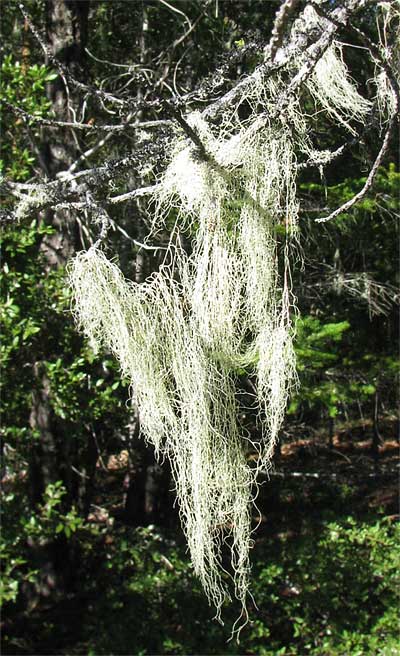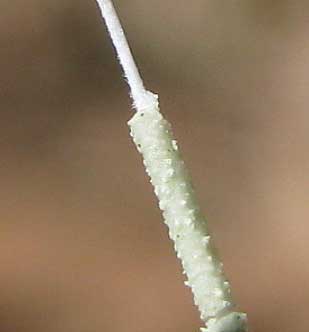Excerpts from Jim Conrad's
Naturalist Newsletter
from the April 26, 2009 Newsletter, issued from the Siskiyou Mountains west of Grants Pass, Oregon:
OLD MAN'S BEARD
If I'm ever hiking in these mountains and somehow end up with an open wound I hope I have enough presence of mind to snatch a handful of Old Man's Beard off a nearby tree and stuff the wound with it. Old Man's Beard is one of several such names applied to a certain greenish-white, bushy, fruticose lichen growing abundantly here, dangling ten or more inches from tree branches, beardlike. You can see one below:

That's the genus USNEA, but the species situation is too confused for me to be certain which species it is. In fact, several lichen genera could be confused with Usnea, but there's a neat trick to know if you have a "real" Old Man's Beard, a species of Usnea. That is, you pull apart one of the lichen's thickest strands and see if there's a white cord inside, as shown below:

It's like a cord wick running through a slender wax candle. Usnea has that cord while other look-alike lichen genera don't.
But, back to our hypothetical wound. For at least a thousand years indigenous Americans applied compresses of Usnea to severe wounds to prevent infection and gangrene. It was also taken internally to fight infections. It happens that Usnea contains the potent antibiotic Usnic Acid (C18H16O7) and is effective against all gram-positive and tuberculosis bacterial species.
I've seen Usnea species all across North America and Europe. It's especially conspicuous here because during much of the year the air is very humid. If there's a tree with dead limbs next to a pond, probably lots of Usnea will be dangling from it. This week I pegged my tent on a high ridge where moist wind from the Pacific filtered through the trees most of the time and the trees were absolutely cluttered with Usnea. Unfortunately, Usnea is sensitive to air pollution, especially sulfur dioxide, so downwind from cities, coal-fired power stations and the like, it largely or entirely disappears.